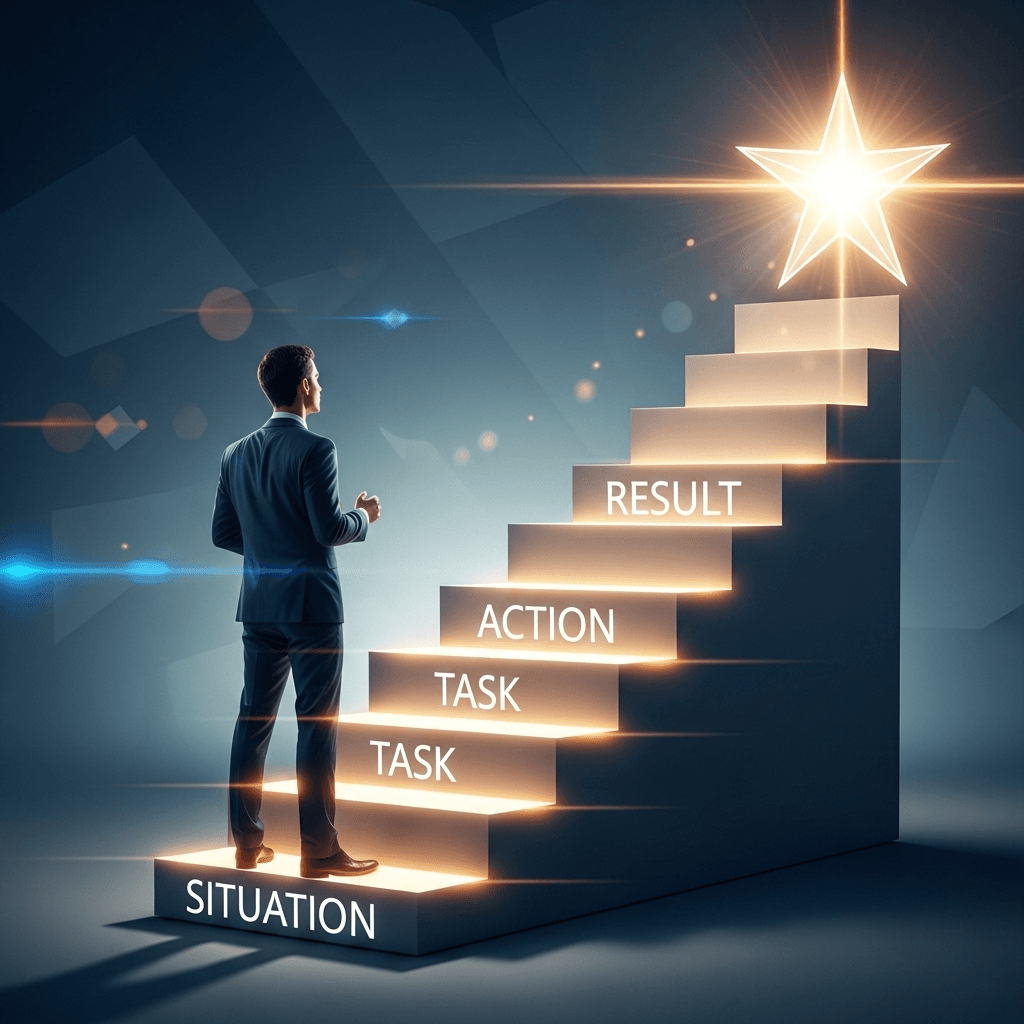The STAR Method: Your Ultimate Framework for Answering Any Behavioral Interview Question

Stop rambling and start impressing. Master the STAR method (Situation, Task, Action, Result) to deliver clear, confident, and powerful stories that showcase your true value.
You’ve polished your resume, written a compelling cover letter, and landed the interview. You feel prepared, but then the hiring manager leans in and says, "Tell me about a time when..." Suddenly, your mind goes blank. You start rambling, connecting unrelated details, and finish your story feeling like you completely missed the mark. If this sounds familiar, you are not alone. Fortunately, there is a simple, powerful framework designed to turn these dreaded moments into your greatest opportunity to shine: the STAR method.
This comprehensive guide will walk you through exactly how to use the STAR method to structure your answers, build your confidence, and leave a lasting, positive impression on any interviewer.
What Are Behavioral Questions and Why Do Interviewers Love Them?
Behavioral interview questions are based on a simple, yet powerful, psychological principle: past performance is the best predictor of future success. Instead of asking hypothetical questions ("What would you do if...?"), interviewers want to hear real stories about how you have handled specific work situations in the past. They aren't just listening to what you did; they are assessing the skills you used to do it, such as problem-solving, leadership, teamwork, and resilience.
Essentially, they want concrete evidence that you have the competencies they’re looking for. Common behavioral questions often start with phrases like:
"Tell me about a time you failed."
"Describe a conflict you had with a coworker and how you resolved it."
"Give an example of a project you led from start to finish."
"Walk me through a time you had to make a difficult decision."
"Describe a situation where you had to work under immense pressure."
Answering these effectively requires more than a simple "yes" or a vague summary. It requires a story, and the STAR method provides the perfect narrative structure.
Breaking Down the STAR Method: A Step-by-Step Guide
STAR is an acronym that stands for Situation, Task, Action, and Result. It’s a framework that helps you structure your answer in a logical, compelling, and easy-to-follow way. Let's break down each component.
S is for Situation
This is the opening of your story. Your goal is to briefly set the scene and provide the necessary context for the interviewer. Keep this part concise—just one or two sentences. Who was involved? Where did this happen? When did it occur? Think of it as painting a quick backdrop for the main event.
T is for Task
Next, you need to explain your specific role or responsibility in that situation. What was the goal you were trying to achieve? What was the specific challenge or problem you were tasked with solving? This clarifies your personal involvement and sets up the challenge you are about to overcome.
A is for Action
This is the most important part of your answer. Here, you must detail the specific, individual steps you took to address the task. Use strong action verbs and focus on your personal contributions. Avoid the "we" trap; the interviewer wants to know what you did, not what your team did. This is where you showcase your skills, your thought process, and your initiative. Be detailed and walk the interviewer through your process step-by-step.
R is for Result
Finally, you need to close your story with the outcome. What happened as a direct result of your actions? Whenever possible, quantify your results with metrics, data, and hard numbers. Did you increase sales by 15%? Reduce project delivery time by 2 weeks? Improve customer satisfaction scores by 10 points? A powerful, measurable result provides a satisfying conclusion to your story and proves your value in a tangible way.
Building Your "Story Bank": How to Prepare Your Top 5 Career Stories
The key to mastering the behavioral interview is preparation. You shouldn't be thinking up stories on the spot. Instead, you should come prepared with a "story bank"—a collection of 3-5 versatile, powerful examples from your career that highlight your key accomplishments.
To start, brainstorm significant experiences related to these core competencies:
Leadership: A time you mentored someone, led a project, or took initiative without being asked.
Teamwork/Conflict Resolution: A time you collaborated successfully or navigated a disagreement with a colleague.
Problem-Solving: A time you identified a critical issue and developed a creative solution.
Overcoming Challenges/Failure: A time a project went wrong, you missed a deadline, or you received difficult feedback, and what you learned from it.
Success/Achievement: A time you exceeded expectations or achieved a goal you are particularly proud of.
The beauty of a well-developed story is its adaptability. For instance, a story about leading a project that was falling behind could be used to answer a question about leadership, problem-solving, or performing under pressure. Practice framing the same core story to fit different types of questions.
STAR Method in Action: Good vs. Great Examples
Let’s look at how the STAR method transforms a weak, rambling answer into a compelling and memorable one. Imagine the interview question is: "Tell me about a time you handled a difficult project."
Weak Answer (Without STAR)
"Uh, yeah, we had this one project that was a real mess. The client kept changing their mind, and we were way behind schedule. It was pretty stressful. We all had to work a lot of late nights, but we eventually got it done and the client was happy in the end."
Analysis: This answer is vague and lacks ownership. The use of "we" obscures the candidate's specific contribution. There are no details about the actions taken and no quantifiable results. It’s forgettable and doesn't showcase any specific skills.
Strong STAR Answer
(S) Situation: "In my previous role as a Marketing Manager, my team was responsible for launching a major digital campaign for a key client, but with only three weeks until the launch date, the client requested a complete change in strategy and creative direction."
(T) Task: "My specific task was to manage this sudden pivot and deliver a high-quality campaign on the original, tight deadline, without increasing the budget."
(A) Action: "First, I immediately scheduled a meeting with the client to fully understand their new vision and establish concrete, non-negotiable deliverables to prevent further scope creep. Next, I reorganized my team, creating two specialized sub-teams: one for creative development and one for media buying. I personally developed a new, condensed project timeline using Asana, assigned clear tasks, and implemented daily 10-minute check-ins to monitor progress and quickly remove any obstacles. I also took the lead on renegotiating terms with one of our media vendors to reallocate funds to the new creative needs."
(R) Result: "As a result of this structured approach, we successfully launched the full campaign on schedule and within budget. The client was thrilled with our adaptability and the final product, which went on to exceed its lead generation goal by 20% in the first month. They signed a new, year-long contract with our agency shortly after."
Analysis: This answer is structured, specific, and professional. It clearly demonstrates the candidate's skills in project management, leadership, negotiation, and client relations. The quantifiable result provides definitive proof of success and impact.
Common Mistakes to Avoid When Using the STAR Method
While the STAR method is a powerful tool, it's easy to make a few common mistakes. Be mindful to avoid these pitfalls:
Making the "Situation" too long: Keep your setup brief. The focus should be on your actions, not the backstory. A long, complicated situation will lose the interviewer's attention.
Focusing on "We" instead of "I": Collaboration is great, but the interviewer is hiring you, not your former team. Even in a team project, focus on the actions *you* personally took. "I organized the meeting," "I created the report," "I persuaded the stakeholder."
Forgetting to share the "Result": An action without a result is an unfinished story. It leaves the interviewer wondering, "So what?" Always close the loop by explaining the outcome of your actions, and quantify it whenever you can.
Your STAR Method Questions, Answered
Here are quick answers to some frequently asked questions about using this technique.
Q: How long should my STAR answer be?
A: Aim for around 90 seconds to 2 minutes. This is long enough to provide sufficient detail but short enough to keep the interviewer engaged. Practice timing your stories.
Q: What if I don't have a direct work example for a question?
A: This is especially relevant for recent graduates or career changers. It's perfectly acceptable to pull from academic projects, volunteer work, internships, or even significant personal projects. The key is to demonstrate the desired skill, regardless of the context.
Q: What if the result was negative? How do I answer "Tell me about a time you failed"?
A: Don't be afraid of this question! Interviewers ask it to gauge self-awareness and resilience. Structure your answer using STAR, but make the "Result" about what you learned. For example: "The result was that the project missed its deadline, which was a significant learning experience for me. I realized my initial planning process was flawed. Since then, I’ve implemented a new system for risk assessment on all my projects, which has helped me deliver my last five projects ahead of schedule."
From Interview Confidence to Job Offer: The Next Step
Mastering the STAR method will undoubtedly make you a more confident and effective interviewee. But acing the interview is only possible if you can get your foot in the door first. In today's hyper-competitive job market, your resume is often your first and only chance to make an impression, and it’s a battle fought against sophisticated Applicant Tracking Systems (ATS).
Too often, highly-qualified professionals are filtered out by algorithms before a human ever sees their application. It’s a rigged game. It's time to fight back.
Who We Are: The Resistance Against the 6-Second Scan
We are Best CV "52", a strategic career advancement service born from this frustrating reality. We are a declaration of war on the lazy, algorithm-driven recruitment process that reduces your entire career to a 6-second keyword scan. Our mission is to fight fire with fire, using superior AI to beat the flawed systems that unfairly sideline top talent.
What We Do: Your Personalized Career Warfare Kit
We don't just "tweak" your resume; we arm you for every single application. Provide us with your CV and a job description, and we generate a complete, AI-powered arsenal, including:
A Perfectly Tailored CV & Cover Letter: Surgically rewritten to align with the job's keywords, the company's culture, and the known biases of their ATS.
Strategic Communication Templates: A full suite of emails (application, follow-up, thank-you) and targeted LinkedIn messages designed to get replies.
A Corporate Dossier & Personal SWOT Analysis: We give you a deep dive into the company and a personal SWOT (Strengths, Weaknesses, Opportunities, Threats) analysis for that specific role, so you can speak their language.
The Interview Arsenal: You've learned the STAR method; now, let us arm you with customized interview questions and strategic talking points that transform your experience into an undeniable match for the position.
Why Choose Us: Because Your Career is Worth More Than 6 Seconds
Stop playing their game. Stop screaming into the void of the "Apply Now" button. It's time to join the resistance. We don't invent experience; we strategically highlight the truth in your career history, translating it into the exact language that both the ATS and the hiring manager need to see.
Visit Best CV "52" today and get the interview you deserve.


